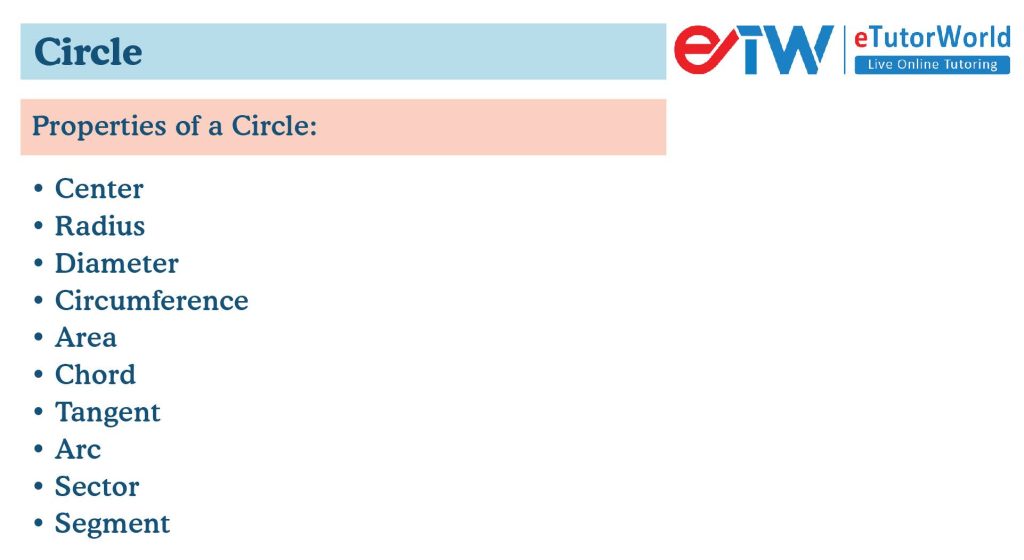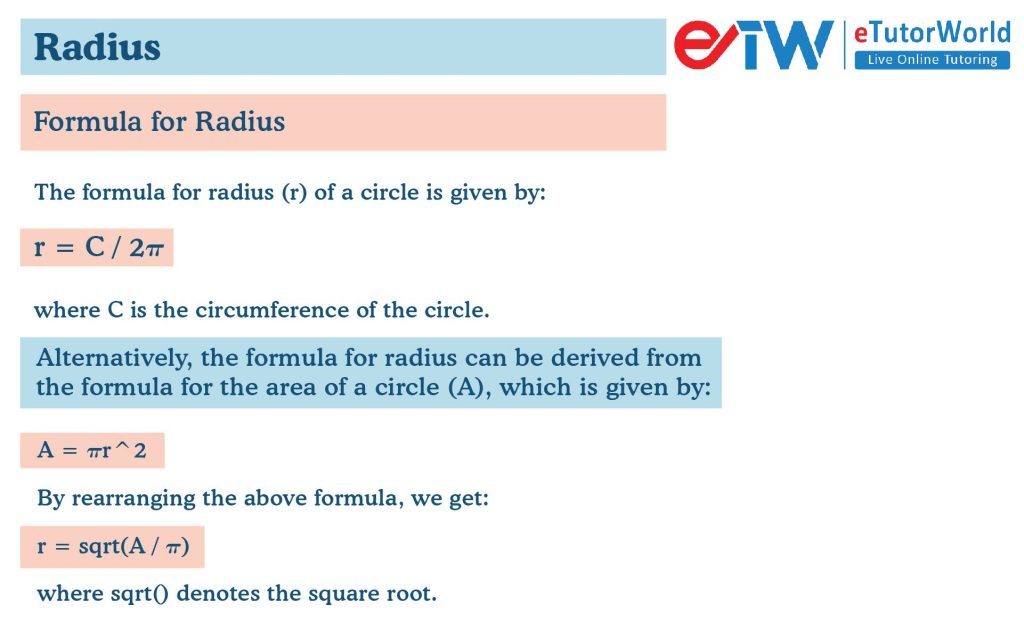Radius, Diameter, and Circumference
Grade 7 Math Worksheets
Welcome to the world of geometry! In this discussion, we will explore three fundamental concepts that form the backbone of circles: radius, diameter, and circumference. These terms are not only vital in geometry but also find applications in various fields.
Table of Contents:
- What is Circle?
- Radius
- Diameter
- Circumference
- FAQs
Personalized Online Tutoring
Radius, Diameter, and Circumference - Grade 7 Math Worksheet PDF
This is a free worksheet with practice problems and answers. You can also work on it online.
Sign up with your email ID to access this free worksheet.
"We really love eTutorWorld!"
"We really love etutorworld!. Anand S and Pooja are excellent math teachers and are quick to respond with requests to tutor on any math topic!" - Kieran Y (via TrustSpot.io)
"My daughter gets distracted easily"
"My daughter gets distracted very easily and Ms. Medini and other teachers were patient with her and redirected her back to the courses.
With the help of Etutorworld, my daughter has been now selected in the Gifted and Talented Program for the school district"
- Nivea Sharma (via TrustSpot.io)
Circle
A circle is a geometric shape defined as a closed curve where all points on the curve are equidistant from a single fixed point called the centre. The distance from the centre to any point on the circle is called the radius.
The length of the curve that makes up the circle is called the circumference. The diameter of a circle is the distance across the process passing through the centre and is equal to twice the radius.
Circles are found in many areas of mathematics and science, including geometry, trigonometry, and physics. They are also commonly used in everyday objects like wheels, clocks, and CDs.
Properties of a Circle
Here are some properties of a circle:

- Center: A circle is defined by a central point called the center. All points on the circle are equidistant from the center.
- Radius: The radius is the distance from the center of the circle to the circumference of the circle.
- Diameter: The diameter is the distance across the circle passing through the center. It is equal to twice the radius.
- Circumference: The circumference is the length of the curve that makes up the circle. It is equal to 2π times the radius or π times the diameter.
- Area: The area of a circle is the amount of space inside the circle. It is equal to π times the square of the radius or one-fourth times π times the square of the diameter.
- Chord: A chord is a line segment that connects two points on the circle.
- Tangent: A tangent is a line that touches the circle at only one point.
- Arc: An arc is a portion of the circumference of a circle.
- Sector: A sector is a portion of the circle that is bounded by two radii and an arc.
- Segment: A segment is a portion of the circle that is bounded by a chord and an arc.
These are some of the main properties of a circle, and they are important in various areas of mathematics and science.
Radius
The radius of a circle is a line segment that connects the center of the circle to any point on the circle’s circumference. It is the distance between the center of the circle and any point on the circle’s edge.

The radius is an important property of a circle, as it is used to calculate other important properties, such as the diameter, circumference, and area of the circle. The length of the radius is denoted by the letter “r”.
The diameter of a circle is equal to twice the radius, and the circumference is equal to 2π times the radius, where π (pi) is a mathematical constant approximately equal to 22/7 or 3.14159.
The area of a circle is equal to π times the square of the radius, or πr^2. Therefore, the radius plays a crucial role in determining the size, shape, and other properties of a circle.
Formula for Radius
The formula for radius (r) of a circle is given by:
r = C / 2π
where C is the circumference of the circle.
Alternatively, the formula for radius can be derived from the formula for the area of a circle (A), which is given by:
A = πr^2
By rearranging the above formula, we get:
r = sqrt(A / π)
where sqrt() denotes the square root.
Therefore, the radius of a circle can be calculated using either the circumference or the area of the circle. These formulas are important in solving problems related to circles in various fields of mathematics and science.
Solved Examples for Radius
Example 1: Find the radius of a circle whose circumference is 30 cm.
Solution: We can use the formula for radius in terms of circumference:
r = C / 2π
Substituting the given value of circumference, we get:
r = 30 cm / 2π
r ≈ 4.77 cm (rounded to two decimal places)
Therefore, the radius of the circle is approximately 4.77 cm.
Example 2: The area of a circle is 78.5 sq cm. Find the radius of the circle.
Solution: We can use the formula for radius in terms of area:
r = sqrt(A / π)
Substituting the given value of area, we get:
r = sqrt(78.5 / π)
r ≈ 5 cm (rounded to one decimal place)
Therefore, the radius of the circle is approximately 5 cm.
Example 3: The diameter of a circle is 10 cm. Find its radius.
Solution: We know that the diameter of a circle is twice the radius, so we can use the formula for radius in terms of diameter:
r = d / 2
Substituting the given value of diameter, we get:
r = 10 cm / 2
r = 5 cm
Therefore, the radius of the circle is 5 cm.
These examples illustrate how to use the formula for radius in different situations, and how it can be derived from other formulas related to circles.
Diameter
The diameter of a circle is a line segment that passes through the center of the circle and connects two points on the circle’s circumference. It is the longest chord of the circle and it divides the circle into two equal halves.
The diameter of a circle is denoted by the letter “d”. It is twice the length of the radius, and can be expressed mathematically as:
d = 2r
where r is the radius of the circle.
The diameter is an important property of a circle, as it is used to calculate other important properties, such as the circumference and the area of the circle. The length of the diameter is a fundamental measure of the size of the circle.
The diameter is also important in many real-world applications. For example, the diameter of a wheel is important in determining its size and compatibility with other parts of a vehicle. In addition, the diameter of a pipe is important in determining its flow capacity and suitability for various applications.
Formulae of a Diameter
The formula for the diameter (d) of a circle is given by:
d = 2r
where r is the radius of the circle.
Alternatively, the formula for the diameter can be derived from the formula for the circumference (C) of the circle, which is given by:
C = 2πr
By rearranging the above formula, we get:
d = C / π
Therefore, the diameter of a circle can be calculated using either the radius or the circumference of the circle. These formulas are important in solving problems related to circles in various fields of mathematics and science.
Solved examples for Diameter
Example 1: Find the diameter of a circle whose radius is 6 cm.
Solution: We can use the formula for diameter in terms of radius:
d = 2r
Substituting the given value of radius, we get:
d = 2 x 6 cm
d = 12 cm
Therefore, the diameter of the circle is 12 cm.
Example 2: The circumference of a circle is 31.4 cm. Find its diameter.
Solution: We can use the formula for diameter in terms of circumference:
d = C / π
Substituting the given value of circumference, we get:
d = 31.4 cm / π
d ≈ 10 cm (rounded to one decimal place)
Therefore, the diameter of the circle is approximately 10 cm.
Example 3: The radius of a circle is 8 m. Find its diameter in centimeters.
Solution: We can use the formula for diameter in terms of radius:
d = 2r
First, we need to convert the radius from meters to centimeters, since the diameter is required in centimeters. One meter is equal to 100 centimeters, so:
r = 8 m x 100 cm/m
r = 800 cm
Substituting the converted value of radius, we get:
d = 2 x 800 cm
d = 1600 cm
Therefore, the diameter of the circle is 1600 cm.
These examples illustrate how to use the formula for diameter in different situations, and how it can be derived from other formulas related to circles.
Diameter from Radius
To find the diameter of a circle when given the radius, you can use the formula:
d = 2r
where “d” represents the diameter and “r” represents the radius.
This formula simply states that the diameter is equal to twice the radius of the circle. Therefore, if you know the radius of a circle, you can simply multiply it by 2 to find the diameter.
For example, if the radius of a circle is 5 cm, then the diameter can be calculated as:
d = 2 x 5 cm = 10 cm
So, the diameter of the circle is 10 cm.
This formula is useful when you only have the radius of the circle and need to find its diameter. It is important to remember that the diameter is always twice the length of the radius, regardless of the size or shape of the circle.
“There have been times when we booked them last minute, but the teachers have been extremely well-prepared and the help desk at etutorworld is very prompt.
Our kid is doing much better with a higher score.”
7th Grade Tutoring
eTutorWorld offers Personalized Online Tutoring for Math, Science, English, and Standardised Tests.
Our Tutoring Packs start at just under $22.49 per hour, and come with a moneyback guarantee.
Schedule a FREE Trial Session, and experience quality tutoring for yourself. (No credit card required.)
Circumference
The circumference of a circle is the distance around its outer edge. It is also defined as the perimeter of the circle.
The circumference of a circle is denoted by the letter “C”. It can be calculated using the formula:
C = 2πr
where “r” is the radius of the circle and “π” (pi) is a mathematical constant approximately equal to 3.14159.
This formula states that the circumference of a circle is equal to twice the radius multiplied by pi. Pi is an irrational number, which means that its decimal representation never ends or repeats.
The circumference of a circle is an important property of the circle, as it is used to calculate other important properties, such as the area of the circle. It is also used in various real-world applications, such as in determining the length of wire needed to go around a circular object, or the distance traveled by a wheel in one revolution.
It is important to note that the circumference and diameter of a circle are related by the formula:
C = πd
where “d” is the diameter of the circle. This formula states that the circumference of a circle is equal to pi multiplied by the diameter.
Circumference from Diameter & Radius
The circumference of a circle can be calculated using either the diameter or the radius of the circle.
If you know the diameter of the circle (d), you can use the formula:
C = πd
where “C” is the circumference of the circle and “π” (pi) is a mathematical constant approximately equal to 3.14159.
Alternatively, if you know the radius of the circle (r), you can use the formula:
C = 2πr
where “C” is the circumference of the circle and “π” (pi) is a mathematical constant approximately equal to 3.14159.
These formulas show that the circumference of a circle is proportional to its diameter and radius, and is directly related to the value of pi. In other words, as the diameter or radius of a circle increases, so does its circumference.
For example, suppose the diameter of a circle is 10 cm. We can use the formula C = πd to find its circumference:
C = π x 10 cm
C ≈ 31.4 cm
Therefore, the circumference of the circle is approximately 31.4 cm.
Alternatively, suppose the radius of a circle is 4 m. We can use the formula C = 2πr to find its circumference:
C = 2π x 4 m
C ≈ 25.13 m
Therefore, the circumference of the circle is approximately 25.13 m.
Solved Examples of Circumfrence
Find the circumference of a circle with a diameter of 8 cm.
Solution:
C = πd
C = π x 8 cm
C ≈ 25.12 cm
Therefore, the circumference of the circle is approximately 25.12 cm.
A circular garden has a radius of 6 m. What is the circumference of the garden?
Solution:
C = 2πr
C = 2π x 6 m
C ≈ 37.7 m
Therefore, the circumference of the garden is approximately 37.7 m.
A wheel has a diameter of 50 cm. What is the circumference of the wheel?
Solution:
C = πd
C = π x 50 cm
C ≈ 157.08 cm
Therefore, the circumference of the wheel is approximately 157.08 cm.
A circular pizza has a circumference of 30 inches. What is the diameter of the pizza?
Solution:
C = πd
30 inches = πd
d = 30 inches / π
d ≈ 9.55 inches
Therefore, the diameter of the pizza is approximately 9.55 inches.
The circumference of a circle is 12π cm. What is the radius of the circle?
Solution:
C = 2πr
12π = 2πr
r = 6 cm
Therefore, the radius of the circle is 6 cm
Do You Stack Up Against the Best?
If you have 30 minutes, try our free diagnostics test and assess your skills.
Radius, Diameter, and Circumference FAQS
What is the difference between diameter and radius?
Diameter is the distance across a circle passing through the center, while radius is the distance from the center of a circle to any point on its edge.
How do you calculate the circumference of a circle?
The circumference of a circle can be calculated using the formula C = 2πr, where “C” is the circumference, “π” is a mathematical constant approximately equal to 3.14159, and “r” is the radius of the circle. Alternatively, the formula C = πd, where “d” is the diameter of the circle, can be used.
What is the value of pi?
Pi is a mathematical constant approximately equal to 3.14159 or 22/7. It is used to calculate the circumference, area, and other properties of circles and other curved objects.
What is the relationship between circumference and diameter?
The circumference of a circle is directly proportional to its diameter. In other words, as the diameter of a circle increases, so does its circumference. The formula for the relationship between circumference and diameter is C = πd.
How is circumference used in real-world applications?
Circumference is used in various real-world applications, such as in determining the length of wire needed to go around a circular object, the distance traveled by a wheel in one revolution, and the size of a circular object, such as a pipe or a ring.

Gloria Mathew writes on math topics for K-12. A trained writer and communicator, she makes math accessible and understandable to students at all levels. Her ability to explain complex math concepts with easy to understand examples helps students master math. LinkedIn
Affordable Tutoring Now Starts at Just $22.49
eTutorWorld offers affordable one-on-one live tutoring over the web for Grades K-12. We are also a leading provider of Test Prep help for Standardized Tests (SCAT, CogAT, MAP, SSAT, SAT, ACT, ISEE, and AP).
What makes eTutorWorld stand apart are: flexibility in lesson scheduling, quality of hand-picked tutors, assignment of tutors based on academic counseling and diagnostic tests of each student, and our 100% money-back guarantee.
Whether you have never tried personalized online tutoring before or are looking for better tutors and flexibility at an affordable price point, schedule a FREE TRIAL Session with us today.
*There is no purchase obligation or credit card requirement
Grade 7 Science Worksheets
- Elements and Compounds
- Solar Energy
- Photosynthesis
- Electricity and Magnetism
- Law of conservation of energy
- Periodic table
- Properties of Matter
- Waves
- Energy Resources
- Weather and Climate
- Immune, Circulatory and Digestive Systems
- Organs in Multi-cellular Organism
- Sedimentary, Igneous, and Metamorphic Rocks
- Structure of the Earth
- Law of Conservation of Mass
- Physical and Chemical Changes
- Scientific Method
- Human Digestive System
- Environmental Science
- Renewable and Non-renewable energy Resources
- Characteristics of Living Organisms
- Life Science
- Earth and Space Science
- Solar Eclipse
- Heat Technology
- Newton’s Laws of Motions
- Physical Science
- Tools, Measurement and SI Units
- Earth Atmosphere
- Interactions of Living things
- The Earth Ecosystem
- Organelles in Plant and Animal cells
- Layers of the Earth
- Cycles in Nature
Grade 7 Math Worksheets
- Fractions
- Linear equations word problems
- Statistics
- Properties of Parallel Line
- Finding slope from an equation
- Identifying Quadrilaterals
- Percent Change
- Properties of addition and multiplication
- Pythagorean Theorem
- Solving two step inequalities
- Symmetry
- Fractions to Decimals (New)
- Whole Number Exponents with Integer Bases (New)
- Adding and Subtracting Fractions (New)
- Integer Addition and Subtraction (New)
- Dividing Mixed Numbers (New)
- Basics of Coordinate Geometry (New)
IN THE NEWS

Our mission is to provide high quality online tutoring services, using state of the art Internet technology, to school students worldwide.
Online test prep and practice
SCAT
SSAT
ISEE
PSAT
SAT
ACT
AP Exam
Science Tutoring
Physics Tutoring
Chemistry Tutoring
Biology Tutoring
Math Tutoring
Pre-Algebra Tutoring
Algebra Tutoring
Pre Calculus Tutoring
Calculus Tutoring
Geometry Tutoring
Trigonometry Tutoring
Statistics Tutoring
Quick links
Free Worksheets
Fact sheet
Sales Partner Opportunities
Parents
Passive Fundraising
Virtual Fundraising
Our Expert Tutors
Safe and Secure Tutoring
Interactive Online Tutoring
After School Tutoring
Elementary School Tutoring
Middle School Tutoring
High School Tutoring
Home Work Help
Math Tutors New York City
Press
©2022 eTutorWorld Terms of use Privacy Policy Site by Little Red Bird
©2022 eTutorWorld
Terms of use
Privacy Policy
Site by Little Red Bird









